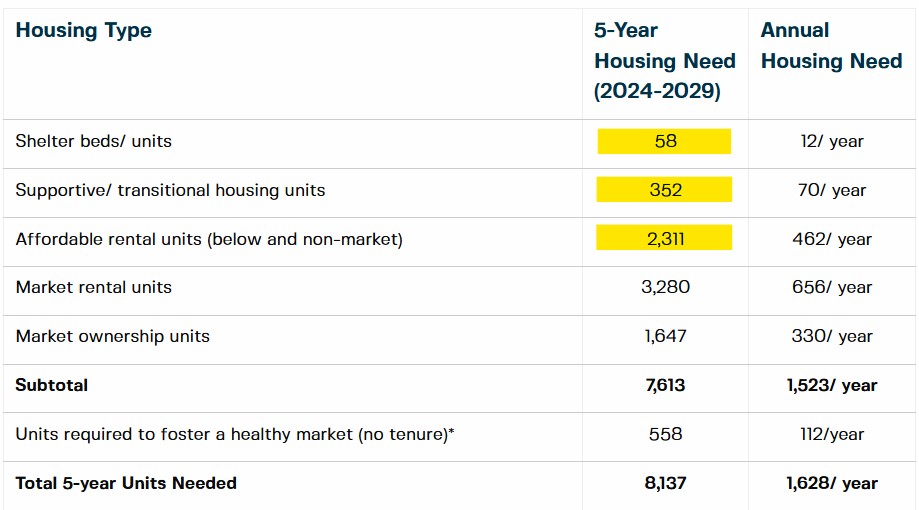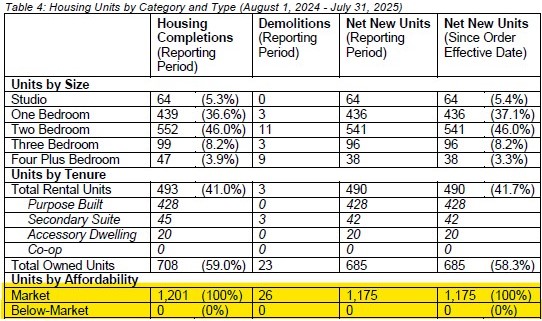As I mentioned when I started this series on our OCP updates, the provincial legislation we are trying to catch up to is almost exclusively about market housing. This means it is working to accelerate the approval and development of primarily strata ownership and purpose-built market rental – the houses over on the right side of the housing spectrum:
In New Westminster in 2025, that means houses that will sell for $1.5 Million, townhouses that will likely be $1 Million, apartments that will be over $700,000 if they are large enough for a bedroom and rents in new market units are not affordable to the average working person.
To be clear: as a City and as a region, we need this market housing despite its apparent unaffordability. much of our current housing affordability crisis is a supply issue – there are simply more people moving to this region than we are building housing for – and cutting off new supply of housing won’t make that better. The last Housing Needs Report we did in New West showed the need for almost 5,000 market ownership and market rental units in the next 5 years. However, the same report showed that we need 2,700 non-market (shelter, supportive, and non-market rental) affordable homes over the same period:

And in reporting out to the Province on our Housing Target Orders, we see that New Westminster is meeting its targets, except in the mon-market part of the spectrum:

The province has introduced more Inclusionary Zoning support, which provides incentives to the market housing sector to build a few affordable housing units with new market buildings. This is a useful tool, but the scale of need is disconnected from what inclusionary zoning can actually supply. The City’s own analysis suggests that asking the development community to build 10% affordable rental units along with market strata may make most market projects unviable. If we ask for more than 10%, we end up with neither the market or non-market need addressed, if we ask for less than 50%, then we need to find another way to get non-market built.
That way, of course, is for the Federal (and to a lesser extent Provincial) Government to invest directly in building affordable housing, at the scale of tens of thousands of units a year like they did from the early 1960s until Paul Martin’s disastrous 1993 austerity budget that got the feds out of the business of affordable housing. Smaller Local Governments don’t have the finances (or the mandate for that matter) to build affordable housing at the scale needed. What we can do is make it easier for the governments with deeper pockets to get the housing built. Pre-approving projects, saying “yes” without creating unnecessary hurdles when projects come to us, providing grant support to reduce the cost of City permits or utility connections, investing our own city-owned land where possible to support affordable housing projects, and actively lobbying the Province and BC Housing for more investment.
The City of New Westminster is already doing all of these things.
We have an Affordable Housing Capital Reserve Fund to provide strategic support and reduce development cost for non-profit builders, we have said “yes” to all of the non-market affordable housing projects brought to Council in my time at the table, and we have amended our Zoning Bylaw to pre-zone areas in the City for secured non-market affordable housing up to six storeys. Now we are taking this the next step to open up more areas of the City for 6-storey secured non-market housing.
In the amendments before Council now we would allow non-profit affordable rental housing of up to six storeys to be built on sites designated in the OCP for Residential Townhouses, and anywhere in Tiers 2 and 3 of the designated Transit Oriented Development area (that is, anywhere within 800m of a SkyTrain Station). Overall, this would mean the majority of lots in New West would be effectively pre-zoned for affordable housing projects like Móytel Lalém, taking a significant planning risk out of the way of non-profit housing providers, and making it easier for them to apply to senior governments for the funding, as that funding is often tied to meeting zoning requirements.
There are also several other smaller changes Staff is proposing to make during the OCP update, some needed to clean up all the small changes and make it a more cohesive plan and map, some to meet other City polices that make sense to formalize at this time. This includes designating “public schools” as a permitted use in the majority of residential and mixed use areas to speed up approval process for new schools when the Province and School District identify new school locations. It is also proposed to update our Frequent Transit Development Areas map to better reflect Provincial legislation and recent updates in the Regional Growth Strategy.
Other changes seem a little more technocratic, but are appropriate at this time. We are integrating the results of our most recent Housing Needs Report into the OCP, to make clear that the OCP provides sufficient planned capacity to accommodate the housing need identified in that report. We are also integrating Climate Action strategies and targets into our OCP (as the Local Government Act now requires). Finally, staff have drafted a new Regional Context Statement to integrate our OCP with the Regional Growth Strategy, which if approved by Council will then go to the Metro Vancouver board for approval.

All told, this is a big piece of planning work that includes not just the City’s planning staff, but engineering and other departments have provided technical background and support, all resulting in the policy and bylaws that back up this map. There has been quite a bit of public engagement that gave some clear feedback on some items and some mixed opinions on others, and all of this will end up in front of Council, then to a Public Hearing, which will no doubt be a big topic of discussion in the fall. If you have opinions, be sure to let us know!